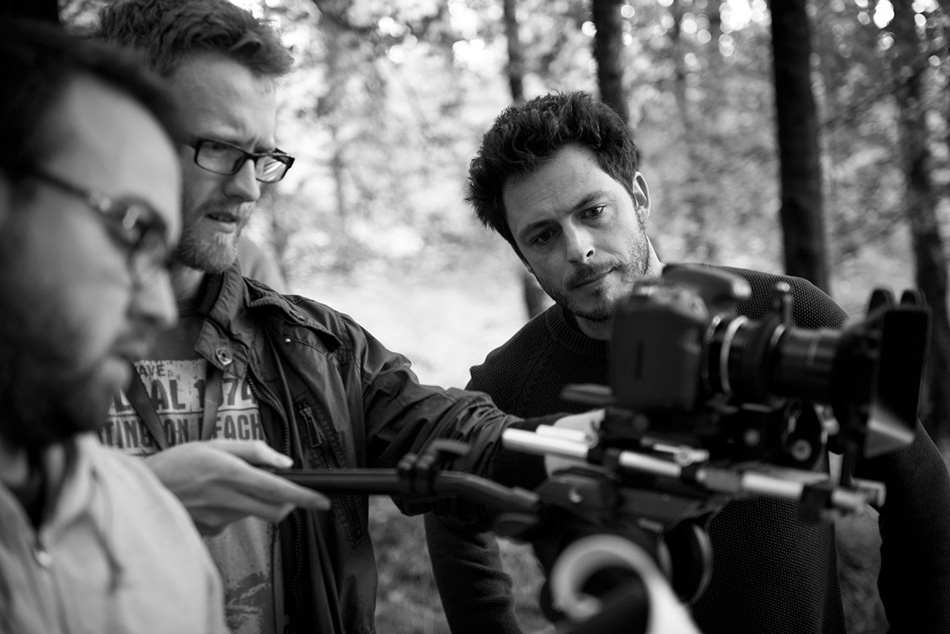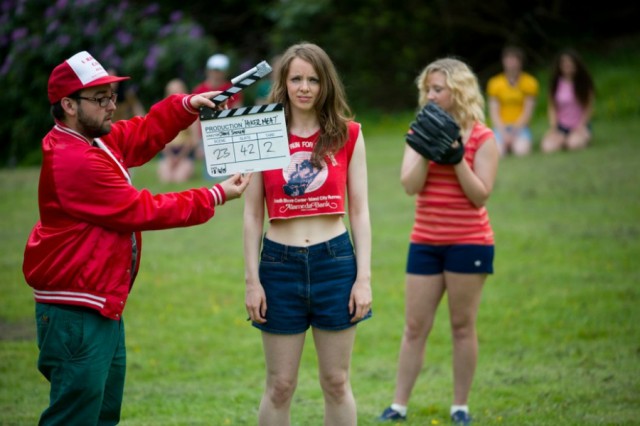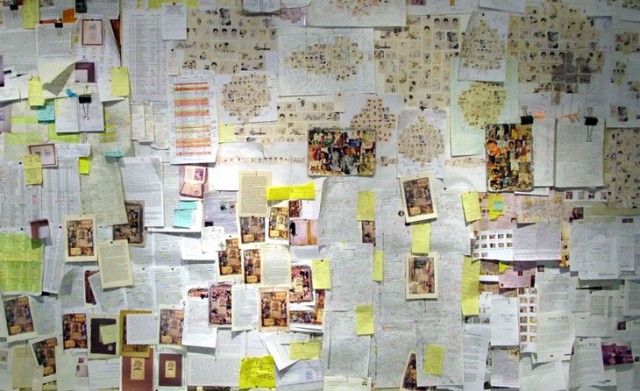The Big Interview: Jamie Shovlin

Metafiction, media manipulation and Charles Saatchi: Linda Pittwood enters the world of artist Jamie Shovlin as they discuss fake archiving and his recent residency at the Bluecoat, Liverpool…
Hi Jamie. It’s very nice to meet you; I’ve been really interested in your work for a long time. How have you found Liverpool, and when did you arrive?
I arrived in April. I didn’t really know Liverpool, I knew Manchester much better. [The opportunity to come here] came at a good time, I had just finished a long project – Hiker Meat – that culminated in an exhibition at the Cornerhouse. I realised on reflection that project had lasted five or six years, although it changed continually throughout, and there was a moment when I realised that when I started it I was in my 20s, and I am now 36.
I’m a compulsive maker, it’s difficult for me to not do anything, but it was a good time for me to take stock and I needed some sort of change. I like the dislocation of coming here, not having a studio, not having a routine, not knowing a place, not knowing how to spend my time on a daily basis. So it’s been great. Starting [a new body of work] is always painful; I forget this when I am working on a project the strands of which started several years previous.
You have been the Bluecoat‘s 2014 Summer Print Studio Artist in Residence. Were you able to start something new during your time there?
The beginning of something often starts with a medium, an approach or a process that I am not familiar with. So screenprinting is what I did here. I have always been interested in screenprinting but didn’t know anything about it. I knew the basic principle of a mesh and image, but [I learnt] through practice and didn’t necessarily approach it in the most efficient way. That is essentially how I work, without much official tutoring or someone going ‘that’s wrong’ because sometimes those wrong things work out well with what I am trying to achieve.
There was no set goal of what was to be achieved in this period of time. The only stipulation was that you had to make an edition. I was conscious that I wanted to make pictures and I wanted to make them in a singular way as opposed to a repetitious edition-based way, which is the traditional way screenprinting is done. I wanted to interrupt that process.
I think I ended up making about 60 or 70 ‘things’, by things I mean outcomes, and about five of them were good. ‘Good’ is probably the wrong word, but there was some sort of bridge between the intention and the outcome. It took me a long time to build up my confidence in relation to the medium. It’s extremely exhausting. But that was important to me that labour intensiveness.
Will you be presenting the outcomes from the residency?
I had this show in Rome, which was scheduled to open the first week of October. The intention was that the work produced [at the Bluecoat] would go into that show but it all got so close to the wire. I was printing onto wood, to me they were the frontispieces of paintings and they were going to have a stretcher on the back. I ran out of time here so I shipped all the work and made the backs out there. That became the end point.

[Also in that show I exhibited] drawings of hands that I produced here, using images of sculptures from the Renaissance, high Western art. These images are strangely aligned to Liverpool, even though they have nothing to do with Liverpool as a place, because as I didn’t have any internet access or anywhere to work when I arrived, I used to go to the Picton Reading Room a lot. And they have these oversized art books in there, really beautiful books, published largely in the ’60s… that are largely image based… and then this rather bitchy scholarship. Really judgmental. The drawings gave some context to what I was doing here [at the Bluecoat] where my hand wasn’t visible.
For the longest time I was engaged principally in process. Which at a certain point, thankfully, segued into something more conceptual, more compelling. I have never had an interest in historic sculpture, I am not sure if I do, but I do have an interest in history making.
Is the show in Rome a solo show?
It’s a two-person show [entitled C/O An alternate correspondence. It’s open now] at Unosunove Gallery with an artist called Philomene Pirecki, who is based in London. Her work is about continually reframing what she is doing. I was doing something similar, but she works directly in the space. I have liked her work for a long time. It’s a form of conceptual painting. It has this inherent idea of time and of place. Formally [her work and mine] work well together. It’s not something I normally think about — tone, colour scheme, we’ve got too much magenta on that wall, that sort of thing.

The old masters you are referencing would have worked with studios in a particular way, for instance, with assistants. Have you ever tried that?
I tried it! At one time I was making work that was more friendly to that way of working. But after a couple of weeks I was struggling to find work for them to do. [What I am doing now is] about contact with the thing whilst you are making it. Building up layers. They aren’t performative or purely durational, but time is very important. People often ask ‘how long did it take you?’ – it’s such a stupid question. Sometimes time does equate to value, but some of the best things I have seen took seconds to produce, even though there is no struggle in them; I am more towards the durational end of the spectrum.
When I was researching for this interview, words like ‘trickster’ and ‘conman’ came up often. I wondered how comfortable you are with this label? Does it refer principally to work you made a long time ago?
The word I dislike most is ‘hoaxer’; it reduces everything to that ‘ha ha I’ve got you!’ moment. Roughly speaking, I have done three projects you could call fake archives. The point of reveal has always been different. Naomi V Jelish (pictured, above) was my first ever show and there was the possibility to engineer an exhibition experience where the viewer wouldn’t know what they were looking at. The structure of the show came from the space; I knew I had two floors in the gallery to work with. One level was the archive of drawings, the ‘front’ of the story being told, and the other level was about the production of the story.
Then there is the Saatchi thing, which I am amused by…
…The myth that Charles Saatchi perpetuated, that he thought the archive was real and the drawings were produced by a 13-year-old girl…
…This ‘myth’ as you say. I had never spoken to the press, I was talking to them genuinely and then they asked me ‘how do you feel about tricking him?’ I knew it wasn’t true but there was a game to play. It was my first show at a well-known gallery and Saatchi was there when I arrived, drinking a cappuccino. He told me [he was going to tell the press he thought the archive was real] and he said to me ‘this is going to be good for me and you.’ What was amazing about the experience, apart from the heightened interest in the work, was the insight into his PR umbrella. He gave a story about each artist in the show to a different publication — newspapers not magazines. My story went to the Telegraph. I now have in the archive genuine press clippings about the show alongside fake press clippings that I made myself. It’s like layers of an onion; he added several layers to the work.
Going back to my original question about Liverpool, I wondered whether place is quite important to how you work? I notice that Cumbria crops up a couple of times on your CV.
The North-West actually as a region has been quite key. I’ve done three or four shows in Manchester, Liverpool and Carlisle. With the Carlisle exhibition – at Tullie House – that project was all about context and site. I was working with the curator Fiona Venables who is amazing, one of the best people I have worked with. She was trying to bring closer together two disparate strands of what the museum was doing – the collections, the research, the historic museum and the very ambitious exhibition programming.
The curators of the collections were very wary because of my reputation. I was there for three years, mostly gaining trust. They would be wanting to show me their best things and I would be interested in a tuna fish under a tarpaulin or an ostrich egg in a toilet roll holder.
I like the edges of collections, museums with an archeology of their own history. I wanted to tell the story of how objects entered the collection. Everything we see has been processed through some mind or collective mind, or its been fictionalised. People put emphasis on different things. This is why I didn’t see working in the museum as that different to my other work [such as the fake archives]. Even if it’s the most verified historical account, it has been shaped by people who always have an agenda.
Linda Pittwood, Arts Editor
Read our review of Jamie Shovlin’s Hiker Meat here
The 2014 Summer Bluecoat Print Studio Artist in Residence is part of a new open call residency programme within the print studio. Artists are selected from a national open call out and, once selected, are invited to experiment within the print studio for a six-week period culminating in an exhibition of their work. Find out more about Shovlin’s work and the studios here





